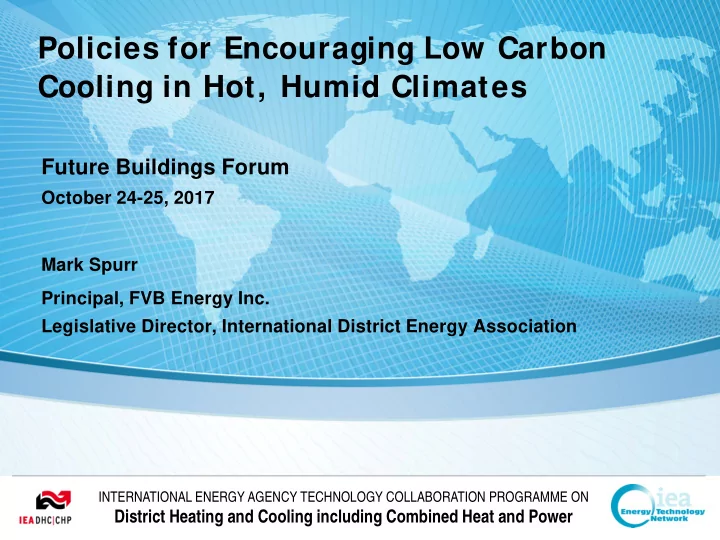

Policies for Encouraging Low Carbon Cooling in Hot, Humid Climates Future Buildings Forum October 24-25, 2017 Mark Spurr Principal, FVB Energy Inc. Legislative Director, International District Energy Association INTERNATIONAL ENERGY AGENCY TECHNOLOGY COLLABORATION PROGRAMME ON INTERNATIONAL ENERGY AGENCY TECHNOLOGY COLLABORATION PROGRAMME ON District Heating and Cooling including Combined Heat and Power District Heating and Cooling including Combined Heat and Power 1
Agenda 1. Introduction to IEA-DHC 2. What’s the problem? 3. Policy nirvana for low carbon energy 4. Policy approaches in an imperfect world 5. Benefits of district cooling 6. Why regulate district cooling? INTERNATIONAL ENERGY AGENCY TECHNOLOGY COLLABORATION PROGRAMME ON District Heating and Cooling including Combined Heat and Power 2
Introduction to IEA-DHC • The IEA District Heating & Cooling (IEA-DHC) Technology Collaboration Programme: was established in 1983 aims to improve the design, performance and deployment of district heating & cooling systems Addresses both technical and policy issues • Research topics focus on reducing cost and improving performance • Member countries from Europe, North America and Asia New members welcome! • 60+ reports are available at the website: www.iea-dhc.org INTERNATIONAL ENERGY AGENCY TECHNOLOGY COLLABORATION PROGRAMME ON District Heating and Cooling including Combined Heat and Power 3
What’s the Problem? 2 • It’s not technology! We can and will make further progress, but we already have the technologies to provide low-carbon energy to cities of the future • It’s the policy framework! We don’t have the right price signals, or policies that correct for an inevitably imperfect market for energy services Technology Policy INTERNATIONAL ENERGY AGENCY TECHNOLOGY COLLABORATION PROGRAMME ON District Heating and Cooling including Combined Heat and Power 4
Policy Nirvana for Low Carbon Energy • What would it take to reach nirvana? Tariffs for energy would reflect full actual costs of energy services Costs would include values for: Capital, operation & maintenance costs o Environmental & social externalities o Price signals would reflect temporal variations in costs, e.g. tariffs would be higher at peak demand to reflect related capex, opex & environmental impacts INTERNATIONAL ENERGY AGENCY TECHNOLOGY COLLABORATION PROGRAMME ON District Heating and Cooling including Combined Heat and Power 5
The World is Imperfect • We are a long way from nirvana Tariffs usually don’t reflect actual costs In many cases energy and water tariffs are heavily subsidized Environmental externalities have not been internalized Political considerations impede nirvana INTERNATIONAL ENERGY AGENCY TECHNOLOGY COLLABORATION PROGRAMME ON District Heating and Cooling including Combined Heat and Power 6
The World is Imperfect • Trends Reduction of subsidies (usually motivated by the need to raise revenues), but progress is slow and results are imperfect Progress in implementing market mechanisms to guide allocation of capital & dispatch of energy resources, but examples are few and short of the mark INTERNATIONAL ENERGY AGENCY TECHNOLOGY COLLABORATION PROGRAMME ON District Heating and Cooling including Combined Heat and Power 7
The World is Imperfect • Given the world as it is, what to do? Advocate for tariff reform to minimize societal economic and environmental costs, including tariffs that address full costs including externalities and temporal cost differences Price signals drive decisions! Mitigate societal impacts through targeted recycling of funds If full cost-based rates are too politically difficult, provide capital and/or operating support for low carbon solutions Consider mandating low carbon systems where such systems clearly minimize total societal costs INTERNATIONAL ENERGY AGENCY TECHNOLOGY COLLABORATION PROGRAMME ON District Heating and Cooling including Combined Heat and Power 8
Benefits of District Cooling • Tap low-carbon sources of cooling energy , e.g. Seawater cooling Combined heat and power • Energy efficiency, carbon emissions and cost-effectiveness all benefit from: Optimal equipment loading Expert operation and maintenance INTERNATIONAL ENERGY AGENCY TECHNOLOGY COLLABORATION PROGRAMME ON District Heating and Cooling including Combined Heat and Power 9
Benefits of District Cooling • District cooling facilitates thermal energy storage , which : Cuts peak demand Saves energy Reduces costs INTERNATIONAL ENERGY AGENCY TECHNOLOGY COLLABORATION PROGRAMME ON District Heating and Cooling including Combined Heat and Power 10
Why Regulate District Cooling? • Economic efficiency District cooling is most cost-effective if all economically feasible customers within a given area are served by the same system • Reduce risks Increase confidence in revenues in the face of uncertainty regarding extent and timing of development Enhance utilization of capital assets Improve operating efficiency through higher loads and load density INTERNATIONAL ENERGY AGENCY TECHNOLOGY COLLABORATION PROGRAMME ON District Heating and Cooling including Combined Heat and Power 11
Why Regulate District Cooling? • Achieve public policy goals energy and water efficiency carbon reduction reliability of supply cost-effectiveness INTERNATIONAL ENERGY AGENCY TECHNOLOGY COLLABORATION PROGRAMME ON District Heating and Cooling including Combined Heat and Power 12
Thanks for your attention! Presenter Contact: Contact to IEA DHC: Mark Spurr Dr. Andrej Jentsch +1-612-607-4544 +49 251 149 12 60 mspurr@fvbenergy.com iea-dhc@agfw.de INTERNATIONAL ENERGY AGENCY TECHNOLOGY COLLABORATION PROGRAMME ON INTERNATIONAL ENERGY AGENCY TECHNOLOGY COLLABORATION PROGRAMME ON District Heating and Cooling including Combined Heat and Power District Heating and Cooling including Combined Heat and Power 13
Recommend
More recommend